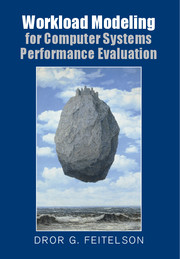Book contents
- Frontmatter
- Dedication
- Contents
- PREFACE
- 1 Introduction
- 2 Workload Data
- 3 Statistical Distributions
- 4 Fitting Distributions to Data
- 5 Heavy Tails
- 6 Correlations in Workloads
- 7 Self-Similarity and Long-Range Dependence
- 8 Hierarchical Generative Models
- 9 Case Studies
- 10 Summary and Outlook
- Appendix Data Sources
- Bibliography
- Index
- References
Bibliography
Published online by Cambridge University Press: 05 March 2015
- Frontmatter
- Dedication
- Contents
- PREFACE
- 1 Introduction
- 2 Workload Data
- 3 Statistical Distributions
- 4 Fitting Distributions to Data
- 5 Heavy Tails
- 6 Correlations in Workloads
- 7 Self-Similarity and Long-Range Dependence
- 8 Hierarchical Generative Models
- 9 Case Studies
- 10 Summary and Outlook
- Appendix Data Sources
- Bibliography
- Index
- References
Summary

- Type
- Chapter
- Information
- Workload Modeling for Computer Systems Performance Evaluation , pp. 501 - 540Publisher: Cambridge University PressPrint publication year: 2015



